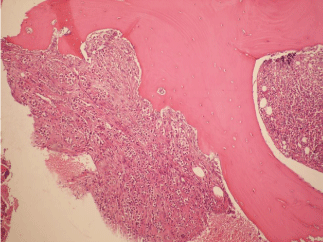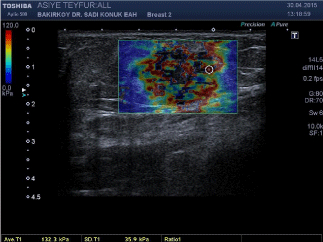Case Report
Pancytopenia: An Unusual Presentation of Breast Cancer: A Case Report
Burak Ilhan1*, Berkay Kılıç2, Süleyman Bademler2, Rüştü Türkay3, Fatma Şen4 and Hasan Karanlık2
1Department of General Surgery, Istanbul University, Istanbul Medical Faculty, Turkey
2Surgical Oncology Unit, Institute of Oncology, Istanbul University, Turkey
3Department of Radiology, Istanbul Bakirkoy Dr. Sadi Konuk Training and Research Hospital, Turkey
4Department of Medical Oncology, Institute of Oncology, Istanbul University, Turkey
*Corresponding author: Burak Ilhan, Department of General Surgery, Istanbul Faculty of Medicine, Istanbul University, Millet Caddesi, 34093 Fatih, Istanbul, Turkey
Published: 30 Jan, 2017
Cite this article as: Ilhan B, Kılıç B, Bademler S, Türkay R,
Şen F, Karanlık H. Pancytopenia: An
Unusual Presentation of Breast Cancer:
A Case Report. Clin Oncol. 2017; 2:
1191.
Abstract
Case Report: This present study reports the case of a fourty nine years old female with a story of
paleness, palpitations and fatigue. Complete Blood Count (CBC) has pointed pancytopenia. A bone
marrow biopsy was performed and the analysis was revealed metastasis of carcinoma. Patient was
diagnosed as bilateral breast carcinoma with bone morrow involvement after physical examination
and specific imaging methods,. No further metastases were identified and taxane and 5-fluorouracil
(5-FU) based chemotherapy with steroid theraphy was started. Surgical intervention of the bilateral
breast was performed following chemotherapy. Patient was disease free during the 4 years of followup.
Conclusion: It is important to attract clinicians attention, if a patient admitted with pancytopenia
,the source can be breast cancer.
Keywords: Bone marrow; Breast neoplasm; Pancytopenia
Introduction
The most common metastatic lesion of the breast cancer is metastasis to contralateral breast [1,2]. Twenty percent of women with operable breast cancer eventually relapse, with about 70% of the relapses as distant metastases [3,4]. Skeletal metastases were seen in patients with metastatic breast cancer, which causes pathologic fractures, spinal cord compression as the result of vertebral compression fracture or extension of the tumor beyond the epidural space, and hypercalcemia. Skletal metastases have rarely results with destruction of the bone tissue matrix by tumor cells. Alkaline phosphatase level in the bone marrow metastasis is worthyespecially where a high osteoblastic activity is typical of breast and prostate cancer metastasis. But metastasis of breast cancer directly to bone marrow is uncommon. Bone marrow micrometastases are in 30.6% of Stage I through III breast cancer patients, total bone marrow involvement and pancytopenia was extremly rare [5].
Case Presentation
Fourty nine years-old woman had presented to our surgery clinic with one month story of
paleness, palpitations and fatigue. Pancytopenia was determined with CBC. White Blood Cell
(WBC) count was 1.4 K/μL, hemoglobin (hgb) was 8.2 K/μL, and platelet count was 112 K/μL.
She was reffered to hematology unit with the suspicion of chronic myeloid leukemia. Carcinoma
metastasiswas determined at the bone marrow biopsy (Figure 1).
Breast masses were determined in the left breast and axillary region in physical examination. At
mammogram, ultrasonography (Figure 2) and MRI an irregular 3 cm mass in the left, 2 cm in the
right breast and pathologic left axillary lymph node was determined. A tru-cut biopsy from irregular
mass of the bilateral breasts and fine needle biopsy from left axillary lymph node were performed
under ultrasonographic guidance. Bilateral invasive lobular carcinoma was determined (Figure 3).
Bilateral breast biopsy revealed tripple negative tumor positron emission tomography was performed
and high metabolic activity was found in upper outer quadrant of the left breast (SUVmax = 9.2) and
in the left axillary lymph nodes (SUVmax = 6.7). Metabolic activity was moderetaly increased in the
bone marrow (SUVmax = 3.2). Taxotere (75 mg/m2) and caphesitabine (500 mg p.o. daily) tratment with steroid teraphy. Bilateral mastectomy, left axillary dissection
and sentinel lymph node biopsy of right axilla were performed.
No metastasis was found on right sentinel lyph node biopsy. The
histolopathologic evaluation of bilateral mastectomy specimens
revealed pathological partial response in both breast tumor. The
patient went on to receive further 6 cyles of capecitabine (2000 mg/m2
per day on days 1 to 14, repeated every 21 days) for her breast cancer.
Patient was disease-free in 4 years follow-up, with complete recovery
of normal bone marrow function.
Figure 1
Figure 2
Discussıon
Bone marrow infiltration with pancytopenia due to breast
cancer metastasis was very uncommon. Bone marrow failure with
pancytopenia as a precursor of the disease is not typically seen [6].
Bone marrow metastasis could frequently occur with advanced or
metastatic breast cancer. There were limited data for treating patient
safely and efficiently, which has pancytopenia due to metastatic
breast tumor involvement. Because clinical trials usually include
patient with near-normal hematologic parameters, the patients with
cytopenias due to bone marrow metastases of breast cancer are also
generally excluded from clinical trials [7]. Additionally, in patients
with hormone receptor negative breast cancer, the myelosuppressive
effect of most cytotoxic drugs complicates attempts at chemotherapy
[8]. Thus, in the literature data about the results of systemic
chemotherapy including response to chemotherapy, severity of side
effects and outcome of the disease is insufficient to guide sytemic
therapy in patients with bone marrow metastasis of breast cancer [9].
In this case, there was increased and highly important infection
risk due to leukopenia, also paleness, throb and fatigue were
occured becauseof anemia. Thrombocytopenia was not so deep. The patient’s dramatic responseto chemotherapy with full leukocyte and
hemoglobine recovery was highly unusual. Pancytopenia is not a
common presentation in patients with metastatic breast cancer. In
rare studies, bicytopenia was noted, which has presented by immune
trombocytopenic purpura and anemia [10].
In our study, bone marrow infiltration with metastatic breast
cancer was the primary cause of pancytopenia. This has rarely been
described in the literature and includes both patients with positive
and negative outcomes from therapy. Another study reported
thatcapecitabine combined with steroid treatment has provided
excellent response, so that treatment has allowed surgery [6]. A patient
received treatment with continuous doxorubicin and zoledronic acid
followed by endocrine therapy, which resulted in complete recovery
of normal bone marrow function with good performance status.
Several reports highlight patients who have responded to systemic
therapy including low dose capecitabine, endocrine therapy and
trastuzumab monotherapy [11-13].
As a conclusion, the authors had aimed to determine the
management of this rare disease. A combination chemotherapy
consisting of docetaxel (75 mg/m2 intravenously on day 1) and
capecitabine (1000 mg/m2 per day on days 1 to 14), each repeated
every 21 days and steroid therapy were initiated in cooperation
with oncology. After two cycles of chemoteraphy, all the cellular
components in blood completely recovered without additional
G-CSF support or transfusion of blood components.Furthermore,
primary tumor regressed without any serious adverse effects. She
completed a total of six cycles of combination chemotherapy. She
was willing to undergo breast operation. Thus, bilateral mastectomy,
left axillary dissection and sentinel lymph node biopsy of right axilla
were performed. No metastasis was found on right sentinel lyph node
biopsy After adjuvant teraphy patient was disease-free in 4 years
follow-up, with complete recovery of normal bone marrow function.
Bone marrow involvement of breast cancer accepted isolated
metastasis and curative surgical treatment provided prolonged
disease-free survival.
Figure 3
Ethics Committee Approval
The Ethics committee approval is Not Available (N/A).
Informed Consent
Written informed consent was obtained from the patient.
Conflict of Interests
Authors have declared that no competing interests exist.
References
- Georgiannos SN, Chin J, Goode AW, Sheaff M. Secondary neoplasms of the breast: a survey of the 20th Century. Cancer. 2001; 92: 2259-2266.
- Kennecke H, Yerushalmi R, Woods R,Cheang MC, Voduc D, Speers CH, et al. Metastatic behavior of breast cancer subtypes. J Clin Oncol. 2010; 28: 3271- 3277.
- Manders K, van de Poll-Franse LV, Creemers GJ,Vreugdenhil G, van der Sangen MJ, Nieuwenhuijzen GA, et al. Clinical management of women with metastatic breast cancer: a descriptive study according to age group. BMC Cancer. 2006; 6: 179.
- Ahn SG, Lee HM, Cho SH, Lee SA, Hwang SH, Jeong J, et al. Prognostic factors for patients with bone-only metastasis in breast cancer. Yonsei Med J. 2013; 54: 1168-1177.
- Hüsemann Y, Geigl JB, Schubert F. Systemic spread is an early step in breast cancer. Cancer Cell. 2008; 13: 58-68.
- Vo JL, Yang L, Kurtz SL, Smith SG, Koppolu BP, Ravindranathan S, et al. Neoadjuvant immunotherapy with chitosan and interleukin-12 to control breast cancer metastasis. Oncoimmunology. 2015; 3: e968001.
- Wong KF, Chan JK, Ma SK. Solid tumour with initial presentation in the bone marrow-a clinicopathologic study of 25 adult cases. Hematol Oncol. 1993; 11: 35-42.
- Rodriguez-Kraul R, Hortobagyi GN, Buzdar AU, Blumenschein GR. Combination chemotherapy for breast carcinoma metastatic to bone marrow. Cancer. 1981; 48: 227-232.
- Ballot J, McDonnell D, Crown J. Successful treatment of thrombocytopenia due to marrow metastases of breast cancer with weekly docetaxel. J Natl Cancer Inst. 2003; 95: 831-832.
- Kopp HG, Krauss K, Fehm T, Staebler A, Zahm J, Vogel W, et al. Symptomatic bone marrow involvement in breast cancer-clinical presentation, treatment, and prognosis: a single institution review of 22 cases. Anticancer Res. 2011; 31: 4025-4030.
- Freyer G, Ligneau B, Trillet-Lenoir V. Palliative hormone therapy, low-dose chemotherapy, and bisphosphonate in breast cancer patients with bone marrow involvement and pancytopenia: report of a pilot experience. Eur J Intern Med. 2000; 11: 329-333.
- Bjelic-Radisic V, Stöger H, Winter R, Beham-Schmid C, Petru E. Long-term control of bone marrow carcinosis and severe thrombocytopenia with standard-dose chemotherapy in a breast cancer patient: a case report. Anticancer Res. 2006; 26: 1627-1630.
- Xu L, Guo F, Song S, Zhang G, Liu Y, Xie X. Trastuzumab monotherapy for bone marrow metastasis of breast cancer: a case report. Oncol Lett. 2014; 7: 1951-1953.



